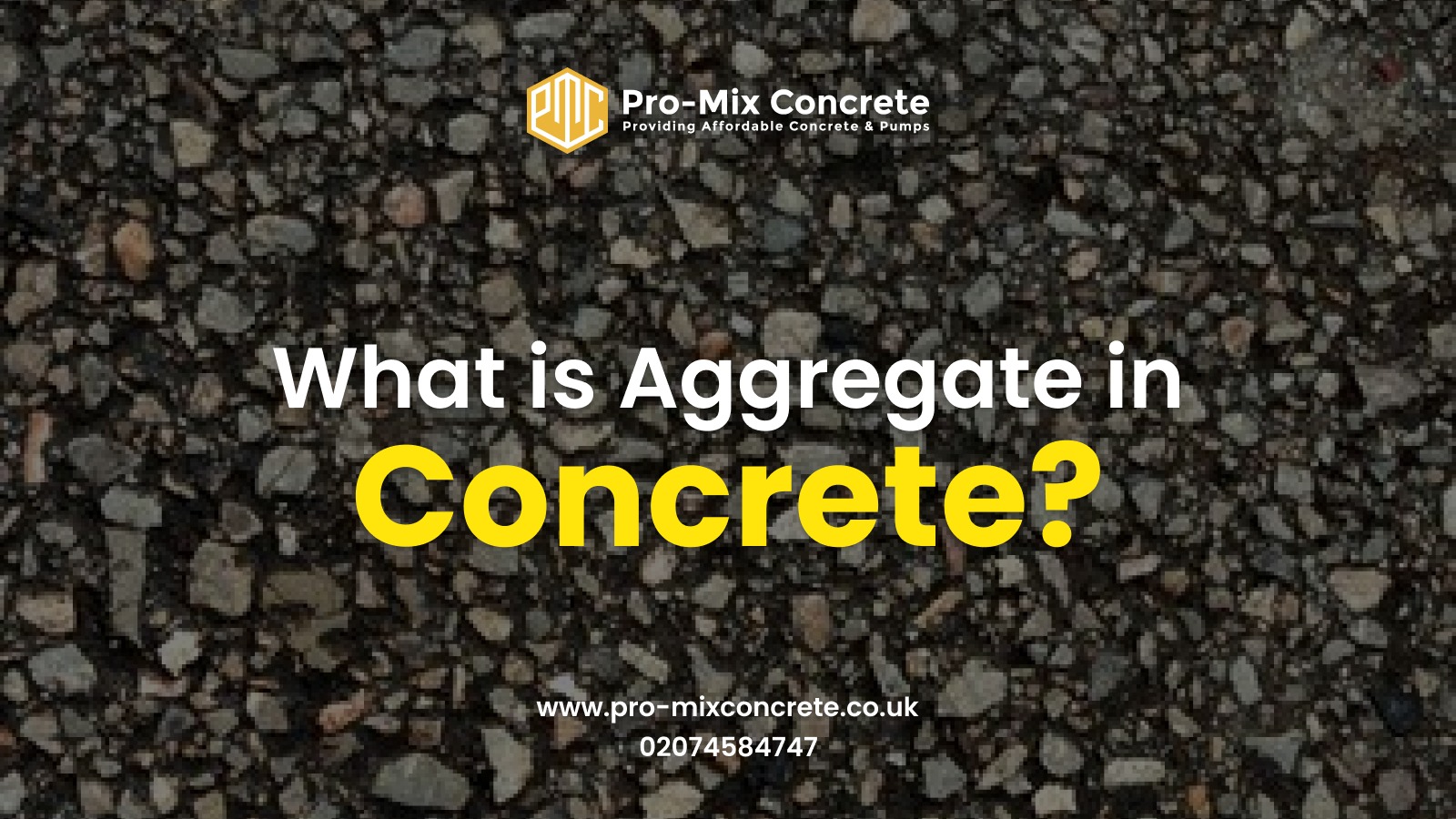Concrete is one of the most important materials we use in construction today. Builders and developers rely on it because it’s incredibly strong and lasts for generations. Just look at concrete structures from centuries ago that are still standing strong! When most people think about concrete, they typically focus on cement. But here’s the thing, concrete is a mix of cement and aggregates.
The function of aggregate in concrete is often disregarded in favour of more obvious components like steel and cement. However, in practice, it acts as the foundation of the concrete mixture, impacting the resilience, power, and even the visual attractiveness of structures. Aggregates must be made of strong and uncontaminated particles to prevent chemicals or coatings from eroding the concrete. Remember, the performance and nature of your finished product can be impacted by the aggregate’s size, weight, and moisture content, among other factors.
What are Aggregates?
Aggregate in concrete consists of granular materials like sand, gravel, crushed stone, and slag that form the backbone of concrete mixtures. These essential building blocks combine with cement to create construction materials such as:
- Portland cement concrete
- Asphalt concrete
Aggregates come in both natural forms (river sand and gravel) and manufactured varieties (crushed stone and recycled concrete).
Their primary function is adding bulk to concrete mixes, which reduces cement requirements while enhancing strength and stability. Aggregates typically constitute 60-80% of concrete’s volume, making them the largest component.
Construction professionals select aggregates based on size, shape, texture, and cleanliness – factors that directly influence concrete performance across different applications.
Read More: What’s the Difference Between Cement and Concrete?
Types of Aggregates in Concrete
Understanding the various types of aggregates helps construction professionals select the right materials for specific projects. What is aggregate in concrete depends largely on its composition, size, and source. Here are the main types you’ll encounter:
Fine Aggregates
Fine aggregates include particles that pass through a 4.75mm sieve. The most common type is natural sand. Extracted from riverbeds, beaches, and gravel pits, natural sand features smooth, rounded particles that improve workability and reduce water requirements in concrete mixtures.
Coarse Aggregates
Coarse aggregates are particles retained on a 4.75mm sieve, including:
- Gravel: Formed naturally through erosion and weathering, gravel comes in various sizes (¾ inch, 1½ inch, etc.) and works well for road construction, concrete production, and decorative applications.
- Crushed Stone: Produced by mechanically crushing larger rocks, crushed stone has angular, rough-textured particles that interlock well, enhancing concrete strength.
- Recycled Concrete: Created from demolished structures, recycled concrete can be processed to appropriate sizes, providing a sustainable alternative with good compaction properties.
Why Is Aggregate Important in Concrete?
The question “do you need aggregate in concrete” has a straightforward answer: absolutely. Aggregates serve several crucial functions that directly impact concrete quality and performance.
Provides Bulk and Volume
Aggregates make up 60-80% of concrete’s volume, acting as an economical filler that significantly reduces the amount of cement needed. This not only lowers costs but also:
- Provides the appropriate volume and density
- Reduces voids to create a more stable structure
- Minimizes the environmental impact of cement production
Boosts Strength
The mechanical properties of concrete, particularly its compressive strength, depend heavily on the aggregates used. Coarse particles provide the main structural support system, while fine aggregates fill the spaces between them, increasing cohesion and workability. The type, size, and shape of aggregates directly influence the concrete’s ultimate strength and longevity.
Improves Workability
Workability refers to how easily concrete mix can be placed, finished, and consolidated. Well-graded aggregates with a balanced mix of particles reduce friction between components, resulting in:
- Smoother, more consistent surfaces
- Easier handling and placement
- Better consolidation with less effort
Minimises Cracking and Shrinkage
Concrete naturally shrinks as it dries, potentially causing cracks. Aggregates help prevent this problem by limiting the overall shrinkage. They create a rigid framework that restricts cement paste movement, reducing concrete cracking and enhancing long-term durability against environmental factors.
Regulates Thermal Properties
Different materials expand and contract at varying rates as temperatures change. Aggregates help control concrete’s thermal expansion and contraction, reducing the risk of:
- Thermal cracking
- Structural damage
- Premature deterioration
Read more: How Often Should I Water New Concrete? Best Practices and Tips
3 Major Properties of Aggregate in Concrete
When selecting the right coarse aggregate in concrete, understanding these three critical properties helps ensure optimal performance:
Gradation
Gradation refers to the particle size distribution within the aggregate. Properly graded aggregates create a dense, well-compacted concrete mix with minimal voids. This reduces the risk of segregation and bleeding while improving:
- Overall density and strength
- Surface finish quality
- Durability against weathering
The ideal gradation includes a continuous distribution from fine to coarse particles, allowing smaller particles to fill the spaces between larger ones. This creates a tightly packed structure that requires less cement paste to fill voids.
Bulk Density and Specific Gravity
Specific gravity (the ratio of aggregate density to water density) indicates aggregate quality and strength. Higher specific gravity values often correlate with stronger, more durable aggregates.
Bulk density measures the mass of aggregate that fills a specific volume, including both the solid particles and the voids between them. This property affects:
- Concrete weight per unit volume
- Material quantities required
- Structural load calculations
- Mix design proportions
Lightweight aggregates produce lower-density concrete suitable for certain applications, while normal-weight aggregates are preferred for structural concrete.
Moisture Content and Absorption
Aggregates can hold moisture in several ways—as surface moisture or absorbed within pores. This moisture content significantly impacts concrete mixing and performance:
- Affects the water-cement ratio
- Influences concrete workability
- Changes the effective mix proportions
- Impacts setting time and strength development
Construction professionals must adjust the water content in concrete mixes based on aggregate moisture conditions. Saturated surface-dry (SSD) aggregates represent the ideal state, where internal pores are filled but the surface remains dry, preventing any influence on the designed water-cement ratio.
Takeaway
Concrete is only as excellent as the aggregate it contains, just as a home may only be as strong as its foundation. This emphasises how crucial it is to choose the proper aggregate, taking into account its shape, texture, and grading in addition to its size.
Pro Mix Concrete goal is to provide you with the optimum type of mix on-site concrete for your project. We promise to offer exactly what you need while complying with the highest industry standards, whether you’re taking on a small residential project or a huge commercial project.
To contact our representatives or evaluate our quality of concrete, you may visit our Instagram page here.
Frequently Asked Questions
10mm aggregate creates smoother finishes ideal for thinner sections and decorative applications, while 20mm aggregate provides greater structural strength and is more economical for foundations and thick slabs. The choice depends on your specific project requirements.
No, using only fine aggregate would create a concrete mix that’s expensive (requiring more cement), prone to shrinkage, and lacking in structural strength. A balanced combination of fine and coarse aggregates is essential.
Quality recycled aggregates can perform similarly to natural aggregates in many applications, though they may have higher absorption rates. They’re an environmentally friendly option that reduces construction waste and conserves natural resources.
Concrete pumping is cleaner than traditional methods, with minimal mess due to the use of pipes and hoses, but some cleanup may still be necessary.
Author
- Dennis Broderick
- Dennis Broderick is the founder and owner of Pro-Mix Concrete Company, a trusted name in ready-mix concrete solutions across the UK. With over 20 years of hands-on experience in the construction and concrete industry, Dennis brings unmatched expertise, practical insights, and a commitment to quality on every project - from residential driveways to large-scale commercial developments.
Latest entries
BlogJune 27, 2025How Same-Day Concrete Delivery Works in the UK?
BlogJune 26, 2025Pre-Mixed Concrete vs. On-Site Concrete Mix
BlogJune 24, 2025Affordable Concrete Supplier in London
BlogJune 22, 2025Concrete Pumping Services: When and Why You Might Need One




